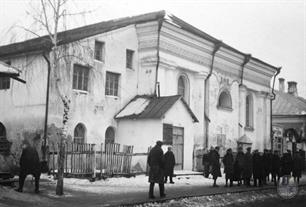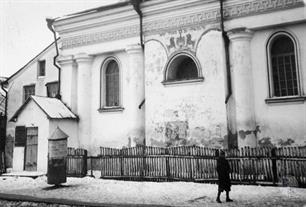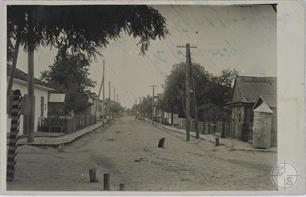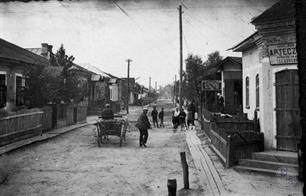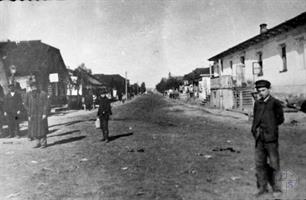Berezne
Rivne district, Rivne region
Sources:
- Russian Jewish encyclopedia. Translated from Russian by Eugene Snaider
- Jewish encyclopedia of Brockhaus & Efron
- The All South-Western Territory: reference and address book of the Kyiv, Podolsk and Volyn provinces. Printing house L.M. Fish and P.E. Wolfson, 1913
- Shtetl Routes. Berezne - guidebook
Photo:
- Biblioteka Multimedialna Teatrnn. Berezne
- European Jewish Cemeteries Initiative. Berezne New Jewish Cemetery
- Biblioteka Narodowa Polona. Berezne
- Russian Jewish encyclopedia. Translated from Russian by Eugene Snaider
- Jewish encyclopedia of Brockhaus & Efron
- The All South-Western Territory: reference and address book of the Kyiv, Podolsk and Volyn provinces. Printing house L.M. Fish and P.E. Wolfson, 1913
- Shtetl Routes. Berezne - guidebook
Photo:
- Biblioteka Multimedialna Teatrnn. Berezne
- European Jewish Cemeteries Initiative. Berezne New Jewish Cemetery
- Biblioteka Narodowa Polona. Berezne
Berezne, city (since 2000), until 2022 - the district center in the Rivne region.
Known since the 15th century. In 16-18 in view - in the Lutsk powiat in the Commonwealth. Since 1793 - as part of the Russian Empire. In the 19th - beginning of the 20th century - a township of Berezna (other name Berenoye) of the Rivne district of the Volyn province. In 1919–39 - in the Volyn Voivodeship as part of Poland, in 1939–91 - as part of the Ukrainian SSR.
In 1765, 267 Jews lived in Berezne,
in 1778 - 79,
in 1787 - 172,
in 1847 - 1283,
in 1897 - 2765 (68.1%),
in 1900 - 2171 (53.8%),
In 1921 - 2372 (58%)
in 1931 - approx. 3200 Jews.
The first Jewish community in Berezne dates back to the second half of the 17th century. There were 48 Jewish houses in the town in 1764, 29 in 1784, and 37 in 1787. Still, it was a small community: its first kahal, umbrella communal organization, was established in the 18th century. It maintained synagogues, educational institutions, a cemetery, the Linat Ha-tsedek Society (A Nightly Shelter for the Righteous), and a hekdesh for the almsseekers.
At the beginning of the 19th century, a local landowner invited Rabbi Yechiel Michele Pechnik (d. 1849) from Pinsk to Berezne. As the legend has it, the local town-owner was jealous of Stolin, a town in Belorussia (today Belarus) that had developed thanks to a tsadik who settled there and his followers, the Hasidim who continually came to town as pilgrims. The town-owner gave Pechnik a slot of land and helped him to build a house, hoping that the famous rabbi would attract Jews to Berezne and that this would bolster the town’s economic development. This happened indeed, and the Pechnik family established here a new Hasidic dynasty, stayed in Berezne from that time onward, and contributed to further economic development.
In 1863 there was a synagogue in the town. At the beginning of the 20th century, Nokhum-Ruven Gutman founded the Zionist organization and heder with teaching in Hebrew.
In Berezne, the typical shtetl architecture has survived in relatively good condition: the town center still has wooden and brick houses with wooden porches. The front part of the houses served as stores or workshops, whose clients could enter from the street. When the children of a Jewish family married, new rooms were built as an addendum to the house. A characteristic feature of the houses in Berezne was their high hip roofs, almost as high as the buildings themselves.
The Great Synagogue was built in 1910, on the basis of a square-shaped foundation with sides measuring 9 × 12 m. It had separate small rooms in which carpenters, tailors, and shoemakers had their separate prayer quorums and prayed on weekdays; the main sanctuary was used for services on Sabbath and holidays.
After World War I, the building housed the Registry Office. Located at 3 Bukhovycha St., it has been completely rebuilt and is hardly recognizable.
Known since the 15th century. In 16-18 in view - in the Lutsk powiat in the Commonwealth. Since 1793 - as part of the Russian Empire. In the 19th - beginning of the 20th century - a township of Berezna (other name Berenoye) of the Rivne district of the Volyn province. In 1919–39 - in the Volyn Voivodeship as part of Poland, in 1939–91 - as part of the Ukrainian SSR.
In 1765, 267 Jews lived in Berezne,
in 1778 - 79,
in 1787 - 172,
in 1847 - 1283,
in 1897 - 2765 (68.1%),
in 1900 - 2171 (53.8%),
In 1921 - 2372 (58%)
in 1931 - approx. 3200 Jews.
The first Jewish community in Berezne dates back to the second half of the 17th century. There were 48 Jewish houses in the town in 1764, 29 in 1784, and 37 in 1787. Still, it was a small community: its first kahal, umbrella communal organization, was established in the 18th century. It maintained synagogues, educational institutions, a cemetery, the Linat Ha-tsedek Society (A Nightly Shelter for the Righteous), and a hekdesh for the almsseekers.
At the beginning of the 19th century, a local landowner invited Rabbi Yechiel Michele Pechnik (d. 1849) from Pinsk to Berezne. As the legend has it, the local town-owner was jealous of Stolin, a town in Belorussia (today Belarus) that had developed thanks to a tsadik who settled there and his followers, the Hasidim who continually came to town as pilgrims. The town-owner gave Pechnik a slot of land and helped him to build a house, hoping that the famous rabbi would attract Jews to Berezne and that this would bolster the town’s economic development. This happened indeed, and the Pechnik family established here a new Hasidic dynasty, stayed in Berezne from that time onward, and contributed to further economic development.
In 1863 there was a synagogue in the town. At the beginning of the 20th century, Nokhum-Ruven Gutman founded the Zionist organization and heder with teaching in Hebrew.
In Berezne, the typical shtetl architecture has survived in relatively good condition: the town center still has wooden and brick houses with wooden porches. The front part of the houses served as stores or workshops, whose clients could enter from the street. When the children of a Jewish family married, new rooms were built as an addendum to the house. A characteristic feature of the houses in Berezne was their high hip roofs, almost as high as the buildings themselves.
The Great Synagogue was built in 1910, on the basis of a square-shaped foundation with sides measuring 9 × 12 m. It had separate small rooms in which carpenters, tailors, and shoemakers had their separate prayer quorums and prayed on weekdays; the main sanctuary was used for services on Sabbath and holidays.
After World War I, the building housed the Registry Office. Located at 3 Bukhovycha St., it has been completely rebuilt and is hardly recognizable.
In 1913, Jews owned both pharmacy warehouses, only kerosene warehouse, only wood warehouse, 138 shops (including all 50 grocery, all 23 manufactory, all 16 haberdashery).
In 1917, a Tarbut school was founded in Berezne, with instruction in Hebrew. The best-known teacher at the school was Yakov Ayzman, who used Hebrew to inspire his students with Zionist ideas. There was also a secular I.L. Peretz School in town, with Yiddish as the language of instruction.
There was also the Peretz Library on Pocztowa Street and a Zionist library on Komisarska Street. In both of them, one could obtain the current newspapers suchas as Der Moment (Yid.: The [Present] Moment) and Voliner Shtime (Yid.: The Voice of Volhynia). The town also boasted a drama group that gave performances in the “Ogniwo” club, located on Komisarska St. (the building has survived to this day).
In the 1930s, the private bank of Drakler was opened, in 1928-the school of the network "Tarbut" and "Yavne".
In the early 1930s, a school with teaching in Yiddish worked.
In the mid-1930s, the Joint attempted to open a school with a professional orientation in Berezne.
In 1917, a Tarbut school was founded in Berezne, with instruction in Hebrew. The best-known teacher at the school was Yakov Ayzman, who used Hebrew to inspire his students with Zionist ideas. There was also a secular I.L. Peretz School in town, with Yiddish as the language of instruction.
There was also the Peretz Library on Pocztowa Street and a Zionist library on Komisarska Street. In both of them, one could obtain the current newspapers suchas as Der Moment (Yid.: The [Present] Moment) and Voliner Shtime (Yid.: The Voice of Volhynia). The town also boasted a drama group that gave performances in the “Ogniwo” club, located on Komisarska St. (the building has survived to this day).
In the 1930s, the private bank of Drakler was opened, in 1928-the school of the network "Tarbut" and "Yavne".
In the early 1930s, a school with teaching in Yiddish worked.
In the mid-1930s, the Joint attempted to open a school with a professional orientation in Berezne.
In September 1939, the Red Army entered Berezne and established the Soviet rule which lasted for a year and a half. In June 1941, the Germans arrived and established a ghetto in the centre of the town (the area is now occupied by a marketplace and a secondary school with a boarding house). More than 3,000 Jews were confined there. On August 25, 1942, all the inhabitants of the ghetto were led out of the town, forced to dig a grave, and murdered by the Einsatzgruppe soldiers.
The local residents remember Doctor Lerner, who used to live with his family in a house on the hospital premises on Piłsudskiego Street (now Kyivska St.). To avoid the ghetto confinement in August 1942, he administered a lethal dose of morphine to his wife and little son, and then to himself. All three of them were buried in the garden next to the hospital.
Few people managed to escape from the ghetto. The fugitives remained in hiding in the woods until the arrival of the Red Army. Seeking to save their lives, they forged identity documents or baptism certificates, and some joined Soviet partisan units.
Towards the end of the 1960s, at the place of the Berezne mass executions, they found exhumed human remains – the result of the sinister activities of grave robbers looking for valuables. Later, a dendropark (Arboretum, a kind of the botany garden with a variety of trees) was established in this area, which to some extent, protected the site and put an end to the practice of digging up graves. In the late 1980s, a memorial plaque commemorating the victims was established.
The local residents remember Doctor Lerner, who used to live with his family in a house on the hospital premises on Piłsudskiego Street (now Kyivska St.). To avoid the ghetto confinement in August 1942, he administered a lethal dose of morphine to his wife and little son, and then to himself. All three of them were buried in the garden next to the hospital.
Few people managed to escape from the ghetto. The fugitives remained in hiding in the woods until the arrival of the Red Army. Seeking to save their lives, they forged identity documents or baptism certificates, and some joined Soviet partisan units.
Towards the end of the 1960s, at the place of the Berezne mass executions, they found exhumed human remains – the result of the sinister activities of grave robbers looking for valuables. Later, a dendropark (Arboretum, a kind of the botany garden with a variety of trees) was established in this area, which to some extent, protected the site and put an end to the practice of digging up graves. In the late 1980s, a memorial plaque commemorating the victims was established.

- Home
- Shtetls
- Vinnytsia region
- Volyn region
- Dnipro region
- Donetsk region
- Zhytomyr region
- Zakarpattia region
- Zaporizhzhia region
- Ivano-Frankivsk region
- Kyiv region
- Kropyvnytskyi region
- Luhansk region
- Lviv region
- Mykolayiv region
- Odessa region
- Poltava region
- Rivne region
- Sumy region
- Ternopil region
- Kharkiv region
- Kherson region
- Khmelnytskyi region
- Chernihiv region
- Chernivtsi region
- Cherkasy region
- Crimea
- Synagogues
- Cemeteries
- Objects & guides
- Old photos
- History
- Contact
Jewish towns of Ukraine
My shtetl
My shtetl
Donate
Jewish towns of Ukraine
